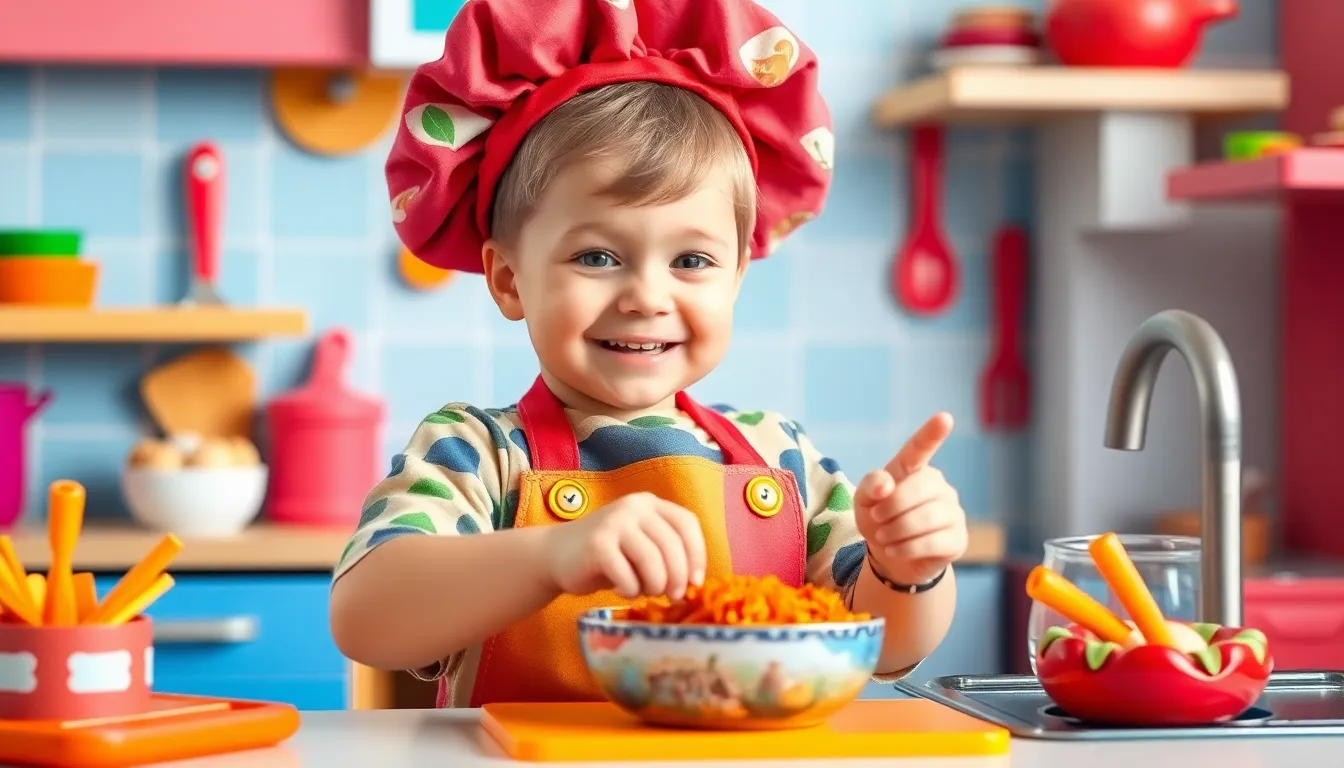In a world where culinary masterpieces often come straight from the microwave, kids kitchen play is the ultimate recipe for creativity. Imagine tiny chefs donning oversized aprons, whipping up imaginary feasts that rival Michelin-starred meals—all without the risk of a smoke alarm going off! This playful exploration not only sparks their imagination but also serves up a generous helping of essential life skills.
Table of Contents
ToggleOverview of Kids Kitchen Play
Kids kitchen play allows children to engage in imaginative cooking experiences that mimic real-life culinary activities. Young chefs can create various meals and explore different roles, such as chef, waiter, or customer. Engaging in this play promotes creativity by enabling kids to invent unique recipes and experiment with pretend ingredients.
As they cook, children also develop essential social skills through cooperative play. Sharing kitchen space and collaborating on meals fosters teamwork and strengthens friendships. Problem-solving occurs when kids face imaginary cooking challenges or unexpected recipe changes, enhancing critical thinking.
Evidence supports that this type of play helps with emotional development. Expressing feelings through role-play allows children to explore different scenarios and develop empathy. Observational skills improve as they watch others in their pretend restaurants, learning from interactions and behaviors.
Imaginary kitchen settings vary widely, from compact playsets to elaborate kitchen layouts. Countless options exist to suit different preferences and age groups, ensuring that every child can find joy in kitchen play. Safety is paramount; therefore, recommended materials include non-toxic plastics and child-friendly tools.
Providers often emphasize the educational aspects of kitchen play. For instance, counting ingredients or measuring portions introduces basic math concepts. Comparing colors and textures also enhances sensory awareness, while storytelling entwines narrative abilities with cooking experiences.
Ultimately, the benefits of kids kitchen play extend far beyond mere entertainment. Providing a platform for creative expression, skill development, and social interaction allows children to grow in a supportive environment, making it an invaluable part of early childhood development.
Benefits of Kids Kitchen Play

Kids kitchen play offers numerous advantages that contribute to children’s growth and development. Engaging in this imaginative activity encourages kids to explore various skills while having fun.
Enhancing Creativity and Imagination
Creativity flourishes in the kitchen play environment. Children envision unique dishes, experiment with combinations, and use their imagination to create vibrant meals. Role-playing as chefs and customers allows them to think outside the box, generating innovative ideas. Pretend cooking sessions also encourage storytelling, as kids invent narratives around their culinary masterpieces. This imaginative play fosters a rich environment for creative expression, ensuring each child enjoys a personalized experience that resonates with their interests.
Developing Motor Skills
Motor skills significantly improve during kids kitchen play. Children manipulate utensils and ingredients, refining their hand-eye coordination while performing various tasks. Cutting, stirring, and pouring enhance fine motor control, establishing essential skills for future activities, such as writing. Using real or play kitchen tools helps kids develop confidence in their abilities and encourages independence. Engaging with different textures and weights also boosts sensory awareness, enriching their overall motor development.
Types of Kids Kitchen Play Sets
Kids kitchen play sets come in various materials and styles, catering to different preferences and play experiences. Here’s a look at two popular types.
Wooden Kitchen Sets
Wooden kitchen sets offer durability and a classic aesthetic. They often feature realistic designs that enhance imaginative play. Crafted from safe, non-toxic materials, these sets withstand rough play, ensuring longevity. Sizes vary, accommodating different spaces. Many sets include accessories such as pots, pans, and utensils, allowing kids to engage in detailed pretend cooking. Wooden kitchen sets also encourage collaborative play, enabling children to share roles and cooperate during sessions.
Plastic Kitchen Sets
Plastic kitchen sets provide lightweight options for children. These sets come in vibrant colors and diverse themes, capturing kids’ attention. Easy to clean, plastic sets withstand spills and stains effectively. They often include interactive features like sounds or lights, increasing engagement levels. Most plastic kitchen sets are budget-friendly, making them accessible for more families. Like wooden sets, they include cooking accessories that help children explore role-playing in various scenarios, such as restaurant management or meal preparation.
Safety Considerations for Kids Kitchen Play
Ensuring safety during kids’ kitchen play is essential. Supervision plays a significant role, as adults should monitor play to prevent risks associated with small parts and choking hazards. Selecting age-appropriate kitchen sets minimizes danger, ensuring that items are designed for specific developmental levels.
Using non-toxic materials is crucial. Many manufacturers provide certifications that validate the safety of their products. Checking these labels helps parents choose toys free from harmful substances. Proper storage also prevents accidents; keeping cooking accessories and utensils organized further promotes a safe play environment.
Teaching children about safety during imaginary cooking enhances their understanding. Introducing simple rules, such as not running while carrying items, fosters responsibility. Encouraging kids to communicate their actions keeps everyone aware of their surroundings while playing.
Incorporating soft play elements in kitchen sets increases safety. Many products feature rounded edges and soft materials, reducing the risk of injury. Additionally, ensuring the play area is free from clutter or sharp objects adds another layer of protection.
Monitoring play time promotes health alongside safety. Limiting continuous play sessions prevents fatigue, which can lead to accidents. Ensuring regular breaks allows children to rest and regroup, supporting both safety and enjoyment.
Implementing these safety considerations helps create a secure kitchen play experience. The focus shifts from just imaginative play to a balanced approach that incorporates well-being and fun. Prioritizing safety not only protects children but also enhances their overall play experience, promoting engagement without undue risk.
Kids’ kitchen play offers a world of imagination and learning. Through playful cooking experiences, children not only enhance their creativity but also develop essential life skills. Engaging in role-play fosters social skills and emotional growth while allowing kids to explore various culinary scenarios.
Choosing the right kitchen set—whether wooden or plastic—ensures a safe and enjoyable experience. Prioritizing safety measures during playtime further enriches the benefits of this activity. Ultimately, kids’ kitchen play serves as a vital component of early childhood development, providing endless opportunities for fun and learning.




